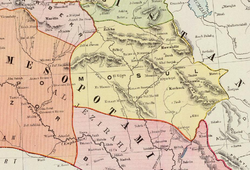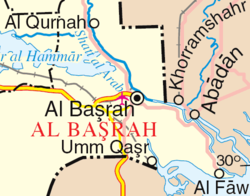معاهدة أرضروم الأولى
 نسخة رسمية من معاهدة أرضروم الأولى. مخطوط فارسي، مكتوب في إيران القاجارية، القرن 19 | |
| النوع | معاهدة ثنائية |
|---|---|
| وُقـِّعت | 29 يوليو 1823 |
| المكان | أرضروم، الدولة العثمانية |
| الأطراف | |
معاهدة أرضروم الأولى (تركية: Erzurum Antlaşması) في يوليو 1823، والتي تلت انتصار القاجاريين على العثمانيين في معركة أرضروم 1823.
عقدت معاهدة أَرضروم عام 1823 بين الدول الأربع، إنجلترا وإيران والعثمانيين والدولة الكعبية، وأعطت المعاهدة إيران مدينة المحمرة وميناءها وجزيرة خضر والمرسى والأراضي الواقعة على الضفة الشرقية من شط العرب.
ولكن القوات الإنجليزية هاجمت عربستان واحتلت المحمرة والأَحواز، واتفقت مع الدولة الكعبية على ضمان استقلالها. وانسحبت في 1857، وبعد ذلك اتفقت الدولة القاجارية مع الدولة الكعبية على أمور أهمها عدم التدخل في شؤونها، وأن يكون لها كيانها المستقل؛ وأن تكون الجمارك تحت إدارة الدولة القاجارية.
. . . . . . . . . . . . . . . . . . . . . . . . . . . . . . . . . . . . . . . . . . . . . . . . . . . . . . . . . . . . . . . . . . . . . . . . . . . . . . . . . . . . . . . . . . . . . . . . . . . . . . . . . . . . . . . . . . . . . . . . . . . . . . . . . . . . . . . . . . . . . . . . . . . . . . . . . . . . . . . . . . . . . . . .
خلفية

The Treaty of Qasr-e Shirin of 1639 and the Treaty of Kordan of 1746 regulated the boundary between the Ottomans and Persians only vaguely. As a result, there were several clashes between the Persian and Ottoman military in the 1820s. Unlike previous border wars, this time the Sunni Ottoman clerics did not issue anti-Shiite fatwas . The Ottoman Sheikh al-Islam wrote to the Persian commander Abbas Mirza to initiate peace negotiationsand stressed the fundamental friendship between the two countries, which are like one body. The first Treaty of Erzurum, concluded in 1823, ended the acts of war, renewed the guarantees of the Treaty of Kordan and supplemented them with regulations for subjects of the Ottoman Empire and Persia in the other country.[1] Thus, for the first time in the history of the Orient, people were no longer identified as citizens of a specific state by their religion, but by their place of birth.[2]
The British and Russians , who had imperial intentions in the region in the course of the “ Great Game ”, were alarmed by the understanding between the Ottomans and Persians without their doing anything and pushed for the conclusion of a second treaty, in the formulation of which they were involved.[2][3] In this second Treaty of Erzurum, which was concluded in 1847, the Ottoman Empire was implicitly assured of control over the entire width of the Shatt al-Arab , in return this area between Khorramshahr and Abadan cameto Persia. The British and Russians interpreted the Persian rights on the left bank of the Shatt al-Arab very restrictively, which the Persian government rejected. [3] The exact course of the Ottoman-Persian border was to be determined by a commission, in which British and Russian representatives were also involved in addition to the Ottomans and Persians. The Commission began its work in 1848, but was interrupted by the Crimean War . In 1869 she made a very inaccurate map of the planned demarcation.[4]
In the period that followed, negotiations rested until 1911, when a new commission consisting of Ottomans, Persians, British and Russians was convened to draw up the exact border. In the Protocol of Constantinople in 1913, the exact course of the border line was finally determined. However, the course of the border in Shatt al-Arab remained controversial.
الأعقاب
The Erzurum Treaties defined people as members of certain state entities and attempted to draw precise boundaries between states' territories, which was a first in the Middle East region . With this, European notions of sovereignty were transferred to the Orient.[2][3][5] The Ottoman Empire and Persia set up consulates to look after their own citizens in each other's territory. Legal security for travelers in each other's territory increased, from which pilgrims to the Shiite holy sites of Najaf and Karbala in particular benefited.[2][1] However, after the end of the Ottoman Empire, Iran voided the 1847 treaty, leading to tensions with the Kingdom of Iraq established under British tutelage . In 1937, Iraq and Iran stipulated in the Tehran Treaty that Iran should control part of the Shatt al-Arab river between the Abadan oil refinery and Khorramshahr. This was of great importance in gaining access to the Anglo-Persian Oil Company 's British oil concessions.[3]
Iran withdrew the Treaty of Tehran in 1967. In 1975, a renewed agreement between Iraq and Iran was reached in Algiers , allowing Iraq to crush the Kurdish Peshmerga in the border area and leaving half of the Shatt al-Arab to Iran. In 1980, Saddam Hussein revoked this agreement and used the unresolved border issue in the Shatt al-Arab and in the Iranian province of Khuzestan as a pretext for starting the First Gulf War.[3]
الهامش
- ^ أ ب IRAQ v. AFSHARIDS TO THE END OF THE QAJARS, Ernest Tucker, Encyclopædia Iranica
- ^ أ ب ت ث From fellows to foreigners: the Qajar experience in the Ottoman Empire, Beeta Baghoolizadeh, University of Austin (Texas), 2012, S. 1, 2, 9, 11–18.
- ^ أ ب ت ث The Iran-Iraq Border: A Story of Too Many Treaties, Randall Lesaffer, Oxford Public International Law
- ^ International Boundary Study, No. 28: Iran–Turkey Boundary, College of Law, Florida State University, Digitized Legal Collections
- ^ Nationalismus in Kurdistan, Vorgeschichte, Entstehungsbedingungen und erste Manifestationen bis 1925 Günter Max Behrendt, Schriftenreihe: „Politik, Wirtschaft und Gesellschaft des Vorderen Orients“ hrsg. vom Deutschen Orient-Institut, Hamburg, 1993, ISBN 3-89173-029-2, S. 33: „Definitive und auf Millimeter präzisierbare Grenzen können nur hochgradig durchorganisierte Territorialstaaten produzieren und langfristig aufrechterhalten. Dieser Typus Staat existiert erst seit historisch kurzer Zeit, selbst noch die machtvollsten Reiche des Mittelalters waren dazu nicht in der Lage – es war für sie allerdings auch kein erstrebenswertes Ziel.“

